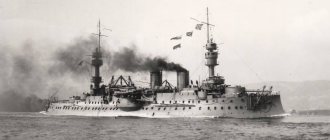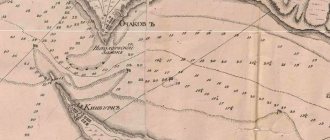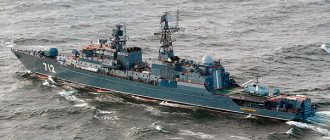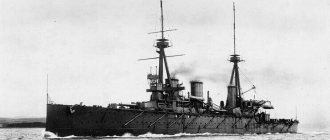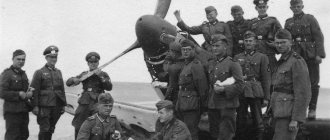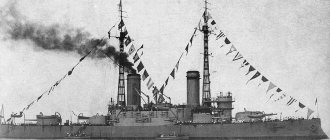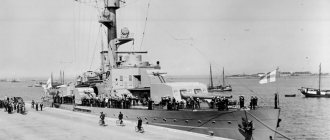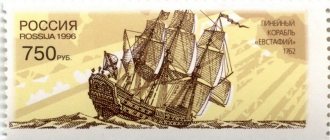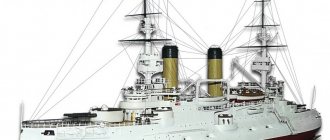And in the end I will tell…
In the center of St. Petersburg there is a monument dedicated to the heroic death of the destroyer Steregushchy in the battle of the Russo-Japanese War. For those who do not know, in its last battle, fighting against superior forces, the Guardian did not sink a single Japanese ship. There is also a monument to the captain of the “Varyag” Rudnev. But the captain of the Amur, Fyodor Nikolaevich Ivanov, was never awarded a monument - just like his ship. Apparently, two battleships out of six that Japan had at that time was “not enough.”
Or a heroic death without much damage to the enemy is considered more honorable than a major military success.
And yet - although the Russian-Japanese war, which was lost, as they say, miserably, still “irons the minds” of patriotic writers who regularly publish regular alternative books on the topic “how to drown Togo”, the author of the article has not yet read a book that would describe the import into Port Arthur additional sets of mines for "Amur" and "Yenisei".
Don't swim behind the buoys!
One of the “urban legends” of the defense of Port Arthur is associated with another Japanese ship that became a victim in this mine war. Allegedly having spied on the Japanese trawling, the brave Russian officers quietly moved the markers from the cleared fairway, after which the Japanese cruiser that entered the bay was blown up by its own mines. The source of this legend was the “Port Arthur Diary” by V. I. Lepko.
Japanese sailors and caught Russian mines
It's funny that all of the above actually happened, just not in the right sequence - Lepko wrote and edited his diary after the war and, apparently, could not always check his memory using documents.
On the same topic
Round armadillos are the fiends of steampunk
According to the report of the ensign of the fleet Deichman, he, commanding an observation post near Kerr Bay, heard two explosions at five o’clock in the morning, and when the morning fog cleared, he noticed two masts of a sunken ship. However, the ensign did not limit himself to simple observation - he took a Chinese boat from a neighboring village, and with two sailors approached the sunken ship and examined it. Moreover, during the inspection, one of the sailors suggested diving and unscrewing the machine gun from the main top, but due to the proximity of the Japanese patrol destroyer, they decided not to risk it. At dawn the next day, the ensign and both sailors went out to sea again and cut the anchor cables at the markers set up by the Japanese to mark the passage through the mines.
The drowned man in the report was presumably called an Asama-class cruiser, since one of these cruisers had previously been seen from an observation post entering the bay. In fact, it was not the Asamoid that perished in Kerr Bay, but a smaller ship, the Miyako with a displacement of 1,800 tons.
Advice "Miyako" in 1902
However, the death of a ship with 2x120 mm and 8x47 mm guns, as well as 200 crew members, of whom only eight survived, was also quite painful for the Japanese. But the act of Ensign Deitchman has nothing to do with this, which does not in any way detract from the courage of this officer: going to sea twice, where there were always enemy patrol ships, was indeed a significant risk. Moreover, he was not a professional military sailor.
On the same topic
The wounded - to the rear: medicine in the Russian-Japanese war
Long-distance skipper Cheslav Boleslavovich Deichman was enrolled as a fleet volunteer by order of S. O. Makarov dated March 8, 1904. At his own request, he transferred to the 5th East Siberian Regiment, which defended Mount Vysokaya, was given command of the 6th company and died in the first battle - November 16, 1904. As for the Miyako, this ship, like the Japanese destroyer No. 48, was blown up by mines laid by the Amur in February 1904.
From the author
I express my deep gratitude to everyone who helped with advice and information. I thought that I knew almost everything in this topic... But no. With every kilobyte I wrote, I became convinced that I knew catastrophically little. And if it weren’t for you, the book would never have happened. I am grateful to everyone, but especially to those who spared no time and effort to help me over these one and a half years:
Gleb Doinikov
Vladimir Igritsky
Anton Filonov
Boris Nader
Sergei Palmin
Without any of them this book would definitely not exist.
And I want it not to be in vain. Men! Let's live in such a way that the following lines never become relevant:
Red splashed in the face of the planets. How eternal and how familiar it is. Rejoice! There are no more knights! Peace and tranquility for your home
A. Belyanin
Black day of the Japanese fleet
On May 2 (15), 1904, the Japanese detachment of Admiral Nasib went out on a patrol that had already become habitual along the blockade of Port Arthur harbor. According to Japanese intelligence, at that time only two battleships were combat-ready in Arthur - Peresvet and Poltava. Three squadron battleships as the main forces of the blockade patrol should have been enough to prevent any attempts by the Russians to interfere with the landing of Japanese troops in full swing.
As they say in such cases, “nothing foreshadowed trouble” - well, except for the very fact of the ongoing war - when at 9:55 a powerful explosion thundered under the keel of the flagship Hatsuse. Built by the British from the Armstrong, the ship turned out to be strong enough and the sea was calm, which allowed the Japanese to begin rescue operations and even try to tow the ship. But when the battleship Yashima moved towards her damaged sister ship to take it in tow, a second explosion was heard, already under it, and a few minutes later a third.
Then the artillery magazine on the flagship battleship detonated and it sank almost instantly, taking half the crew to the bottom to the accompaniment of indiscriminate firing from the surviving Japanese ships at the “Russian submarine.” The samurai tried to drag the second wounded man to the base, but then it became clear that the water was coming faster than it was being pumped out - and the fleet of the Land of the Rising Sun lost another battleship.
The sinking of the Japanese battleship Hatsuse
This was far from a complete list of Japanese losses during the day. On the same day, due to thick fog, the armored cruiser Kasuga rammed... the Japanese armored deck Yoshino, which also quickly sank with most of its crew. But the Russian sailors had no direct connection to this “victory,” unlike the death of two squadron battleships.
This victory became the greatest achievement of the Russian fleet not only in that war, but in all subsequent ones.
Neither the RIF nor the Soviet fleet that replaced it achieved success on this scale; almost thirty thousand tons of combat tonnage of two Japanese battleships remained an unsurpassed achievement. And this success was achieved not by numerous admirals, not by the main caliber guns of battleships, but by captain 2nd rank F.N. Ivanov and his minelayer “Amur”.
Not only “Cupid”...
The combat career of the most successful ship in the Russian fleet ended a little over a month later - on June 3 (16), 1904, when approaching Golubina Bay, the Amur touched a rock not marked on the map and ripped through the bottom. Although Ivanov managed to bring the mine fire to the port, they no longer began to repair the ship - the repair capacity of the port was loaded with more “valuable” ships... and besides, there were no longer enough mines in Arthur for which it would be worth restoring the mine fire.
At the end of December 1904, the Amur was blown up (photo source)
The remaining mines were deployed from destroyers, on which, by order of Admiral Witgef, wooden guides were mounted - the so-called “Port Arthur skids”. They were tested for the first time on July 22, when the destroyer Resolute, under the command of Lieutenant Roshchakovsky, laid ten spherical mines 11 miles from Port Arthur.
But the most successful was the second destroyer converted for mining, the Skory, under the command of Lieutenant P. M. Plen. On the evening of August 20, 1904, he set up a 16-mine barrage between Cap Island and Lunwantan Bay. The next day, a couple of Japanese destroyers from the blockade groups passed through them. The Hayatori was unlucky - it hit a mine, broke in half and sank with 20 crew members. But the same type “Harusama” was blown up by a mine on October 10th southwest of the Golden Mountain, but remained afloat - only eight people were injured.
Another "prey" of the "Skorogo" mines was the "Heyen" - a 1st class gunboat (although in another country this former Chinese armored cruiser with 2640 tons of displacement and a powerful armor belt would have been awarded the title of a monitor or even a coastal defense battleship).
Former Chinese armored cruiser Pingyuan, which became a Japanese gunboat
This disruption also affected the land front. Just in the midst of the 1st Japanese Division's assault on Mount Vysokaya, one of the three ships of Captain 2nd Rank Tajima, which was supposed to support the attack, ended up at the bottom of the sea. On the second - "Sai-yen" - Tajima went to look for the loss, and as a result, only "Akagi" was engaged in shelling the shore. As a result, the Japanese offensive failed, and soon the Sai-yen found a Russian mine.
On the same topic
Tsushima: did the Russians have a chance to avoid defeat?
This has already produced more than just a tactical effect - on December 1, General Nogi sent a telegram to the commander of the fleet: “I am deeply grateful for the assistance to the army that was provided by a detachment of ships of the United Fleet, but the army can no longer demand help from the ships, since they themselves are in danger: what As for stopping the supply of contraband, although from the very beginning it was desirable to completely stop its access, one could be content only with measures in which precious warships would be kept in a safe area.”
